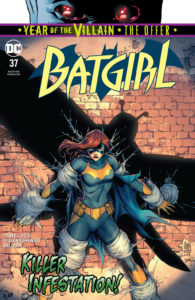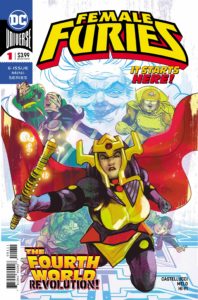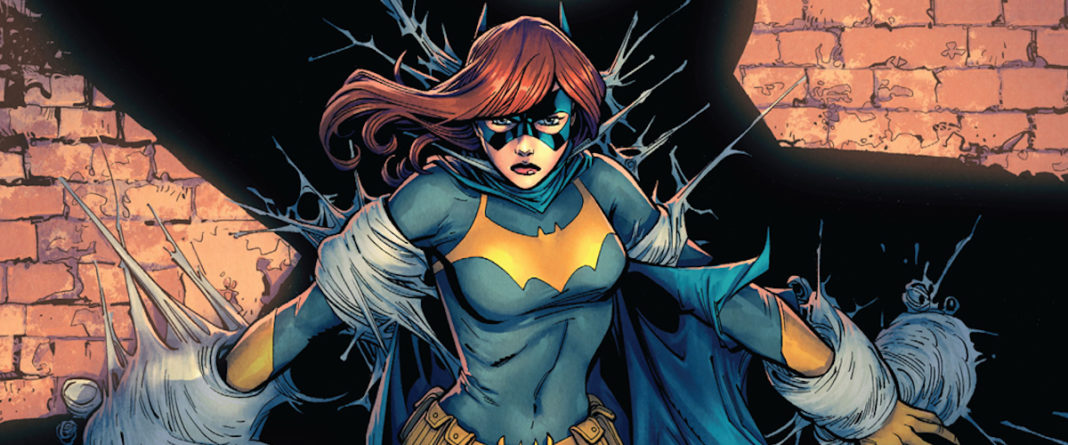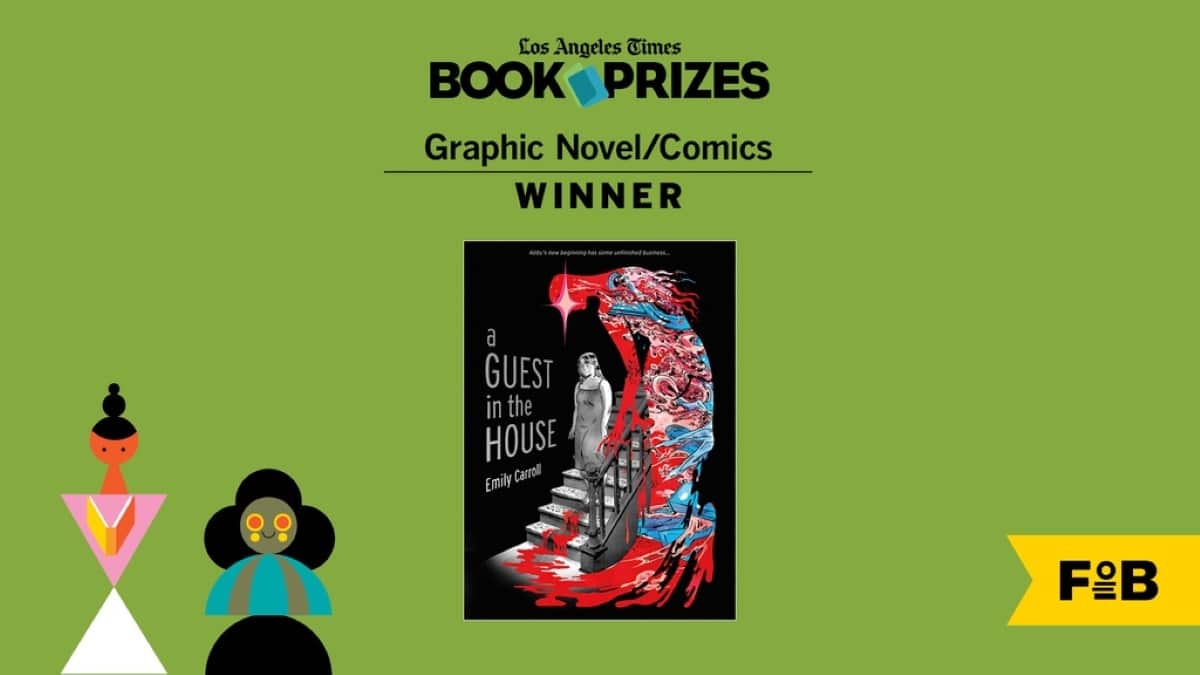By Chloe Maveal
I have to admit that when DC reached out to offer me an interview at San Diego Comic-Con with Female Furies writer Cecil Castellucci, I couldn’t reply, “Yes, please, thank you very much, yes,” fast enough.

Having lived an incredibly full and absurdly interesting life that has included a career in film, music, and novels, Castellucci began reaching out into the world of comics first in 2007 with P.L.A.I.N. Janes and later with two DC mini-series: Shade, The Changing Girl and most recently, Female Furies. But Cecil has a new hero to explore with Batgirl #37, which hits shelves July 24.
The issue begins as a part of DC’s anticipated crossover event Year of the Villain, which sees Barbara “Batgirl” Gordon dealing with the cost of hero work, getting back on her feet, and of course — a heated fight with famously absurd villain Killer Moth.
I was fortunate enough to have time to sit down with Cecil Castellucci during SDCC and get to the bottom of what we can expect from her run on Batgirl.
Maveal: When I read the issue, I noticed that there was a lot of references to money throughout the fight between Batgirl and Killer Moth. From her being, “Oh I can’t use my cold suit because I can’t replace it! I need to go pick up these Batarangs because where am I gonna get more?” But even Killer Moth brings up that he spared no expense. It’s something that’s never really talked about much in comics, which is: what is the cost of hero work or super villainy? Is there a particular reason why you chose to include that?
Castellucci: In the issue right before mine with Mairghread [Scott]’s run, she lost her company and her apartment…so Barbara is sort of broke. So I think the fact that she lost Gordon Clean Energy and the fact that she suddenly has to think about the cost of this stuff is important. And the history of Killer Moth is that he’s kind of like this rich guy who spent all of his money on trying to help out vigilantes and stuff like that; so the idea was that he also has just run out of money. But it’s like what you said, with the question of, what is the actual cost of super technology?
Maveal: It gets broken and weird if you think about it for too long.
Castellucci: It totally does. So it was kind of a nice way to introduce sort of a real-world thought process. I really want to make sure we understand that Barbara is really trying to make it on her own right now needs to figure it all out because suddenly she has to think about the real cost of things and the cost of using up resources. I’m giving her a taste of the real world.
Maveal: Killer Moth also mentions that he’s showing off enough so that Lex [Luthor] will give him an offer. While Killer Moth has traditionally been a Batgirl villain, there’s also a bit in your first issue where he makes the snipe that she’s just a girl. Within that universe, there are plenty of superheroes that he could have gone after as a show of force. Does it tie back into the idea that Barbara is “just a girl” and is therefore an easier kill, which makes an easier target to catch Luthor’s attention?
Castellucci: I think that in Killer Moth’s mind, a Bat — any Bat — is of high value and would get Luthor’s attention. But Killer Moth is kind of a joke; historically he’s kind of a buffoon. I think that his confidence level — mistakenly so — was like, “Welp. Better do something where I look good.” And in his mind, that was Batgirl.
Also, if you look at Batgirl: Year One they say to her, “Oh, you’re a girl.” And she constantly has that thrown at her; but often as women we have to prove ourselves; we have to work just a little bit harder. He has, as you saw, a lot of technology right now and he’s not looking like a buffoon anymore…so it’s kind a thing where they are both underestimating each other. I think that’s interesting too, because when you look at Killer Moth he’s always been underestimated and even she is just like, “This will be a piece of cake!” And this time it’s not a piece of cake.
I just really liked the idea of them both underestimating each other and having to reassess. That feels like a theme for Batgirl moving forward right now.
Maveal: A lot of people associate Barbara and Oracle as being the same person because of her accident. But historically, we’ve been Barbara as Oracle, we’ve even seen Gus as Oracle… but now in your series, Oracle seems to be their own entity like an A.I. Can you shed any light on that?
Castellucci: I don’t know how much light I can shed! I will say that I think what you’re thinking is correct. When you look at the Year of the Villain across all of the books that it’s dealing with, each villain is one that challenges the hero to the core. And so I think what I can safely say is that Batgirl is going to be challenged and is going to be challenged to her very core.
Maveal: Well you’ve got me, personally, very much on the hook with that one. Hopefully the tone of what you just said translates in this being written up, because it’s fantastically mysterious.
Castellucci: I think what’s best to say is that what you suspect is right. But I haven’t said anything! I can’t say anything else!

Maveal: Obviously I have to bring up Female Furies as well when getting the chance to talk to you! Batgirl seems like a really drastic switch from Female Furies. The Batgirl universe is so much more contained and with Female Furies, you had the Fourth World to tap into and all of time and space to play with basically. How does it feel coming back down to earth?
Castellucci: The compelling thing about doing something like Female Furies is that it’s a fixed number of issues — like, a six-issue mini-series — that’s not in continuity. It is very challenging to come into the DC Universe — which is a shared universe — and to begin my run on Batgirl during an event where I can’t come in like, “This is what I want to do with Batgirl.” It’s me coming in with like…an EVENT.
So that’s very grounding in a way, but it’s thrilling because I’ve worked a long time in comics and I’ve always wanted to dip my toe into the DC Universe. So as difficult as it is coming back to earth, it’s also a really thrilling exploration. I still feel like my goal, eventually, will be to do another mini-series like Female Furies or Shade, the Changing Girl and crack or reinvent another character in the DC universe, but outside of continuity as well. I think that will make me whole.
Maveal: Now that it’s finished, do you feel like Female Furies was well-received? Do you feel like you accomplished what you wanted to with the story and the messages that you put out with it?
Castellucci: I feel like we accomplished what we wanted to do. I read the Fourth World very closely and… I see that some not-nice people say that I didn’t do my homework or whatever, but I can point to panels in all of the issues and say, “This is from New Gods. This is from Mister Miracle. This is from The Forever People.” What I really did was exploded moments from what Jack Kirby did already.
Maveal: It really felt to me like you filled in some of the gaps.
Castellucci: Yes! I wanted to fill in the gaps. And even from the way that Aurelie dies to the way that Apokolips ends at the end of my book is what happens at the end of the Fourth World — well, to a certain extent. Not quite. I’m my own person, of course. And when it came to the feminist stuff, the awakening of Barda is exactly the awakening that Barda has [in Mister Miracle]. It’s how she meets Scott Free! It’s how she goes to earth and how the other Furies follow her there! Everything is pretty much the same. I honestly felt like I just turned up to 11 what Kirby had left for me to do.
And I’m a woman; I’ve lived in the world and I’ve dealt with some things so it was very powerful to be able to do that awakening with these women on Apokolips. With that said? Yeah, people were mad! I think that people either really got it and loved what we did or people were very, very, VERY upset about it. And of course I want everyone to love everything; but I think that you know you’re doing something right when it’s polarizing.
Maveal: [Female Furies] seemed to have a fantastic underlying discussion of generational attitudes in feminism.
Castellucci: Yes. YES! Oh, thank you so much for noticing that! That was very much intentional!
Maveal: Do you feel like Batgirl is going to afford you the same ability to send messages and make subtle commentary like it did with Female Furies?
Castellucci: I am definitely going to try my darnedest! I don’t think that DC would ask me to do Batgirl if they didn’t know what my flavor is. That’s who I am and I’m interested in bringing that again. When you look at the history of Batgirl and the things she tried to accomplish in the Bronze Age, she really was an original feminist. I can’t not do that. I feel like ladies who came before me like Hope Larson and Mairghread Scott also infused their own brand of [feminism] into it. And I’m really excited because Year of the Villain is going to give Batgirl the opportunity to kind of reevaluate herself.
Maveal: I could probably talk to you about this for the rest of the evening but I’m sure we need to start wrapping up! So what kind of ambitions do you have for Batgirl? Do you have plans to mould her to fit your style as well as fit in with the style and theme of Year of the Villain?
Castellucci: Oh, sure. But I think it gets really hard when you’re in a crossover event because there’s so many moving parts and you have to honor what the direction is. I feel like I’m going to be able to do more of that once we get through Year of the Villain. I’m trying to seed things in that will hopefully take her into new directions later on.
Cecil Castellucci and Carmine Di Giandomenico begin their run on Batgirl #37. The issue is on stands now.








The young novelist (at her age) is an inspiration for all of women. I’m waiting for any news about her new project The Female Furies for DC Comics. Feminism issues are really crucial today – not only for the mere discussion on gender debates, but also for the topicality of the traditional and non-traditional points of view.
The young novelist as she is, Cecil is an example of inspiration and enthusiasm for all women. I’m waiting for the recent news about her new project The Female Furies for DC Comics. Feminism today is not only a talk about gender, it’s more about traditional vs non-traditional approach to thinking.
https://hireessaywriter.org/
Comments are closed.